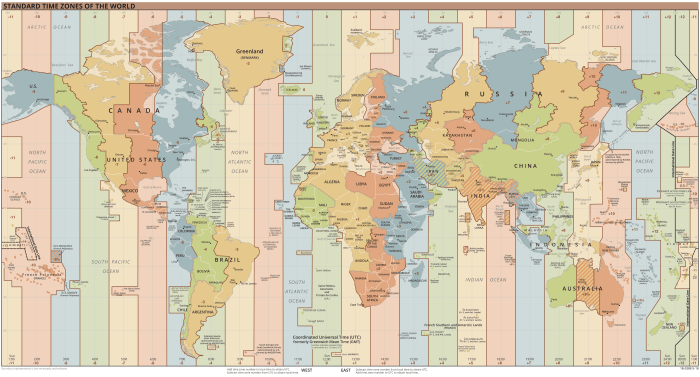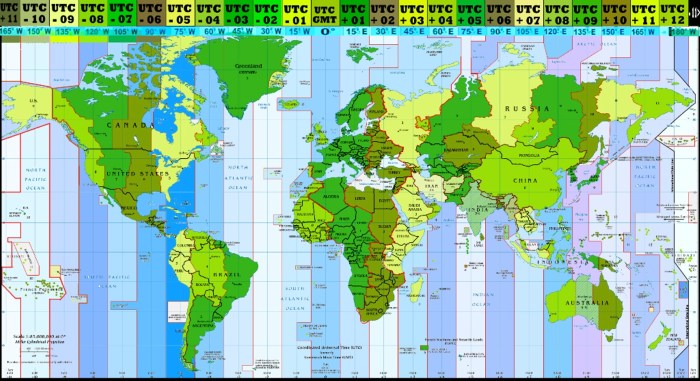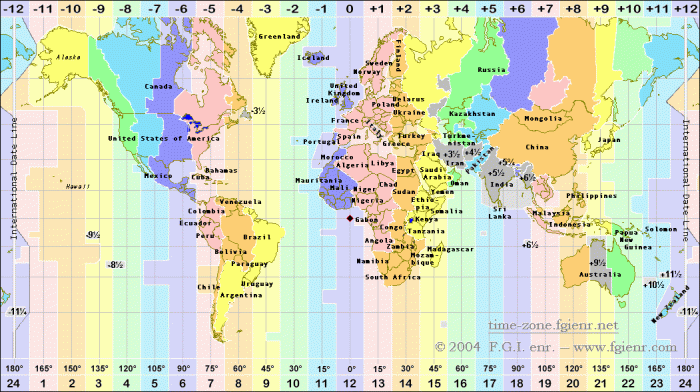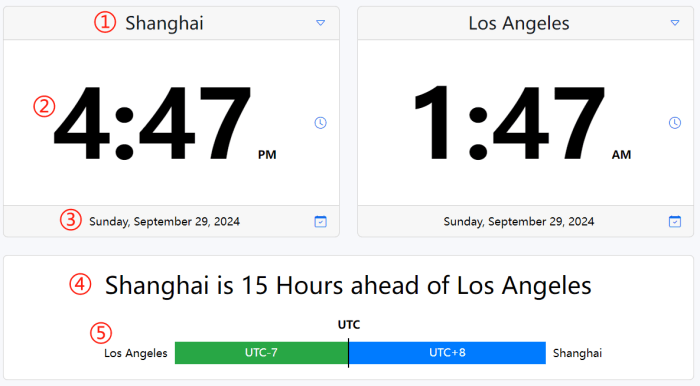Time Zone Differences Global Coordination
Imagine a world without synchronized time – a chaotic jumble of overlapping schedules and missed deadlines. The seemingly simple concept of time zones underpins global communication, commerce, and travel, impacting everything from international business meetings to the precise timing of satellite launches. Understanding these differences is crucial for seamless global interaction.
This exploration delves into the history of time zones, their calculation, the challenges posed by daylight saving time, and the myriad ways these differences affect various industries. We’ll examine practical solutions for navigating time zone complexities and provide tools and strategies for effective global coordination.
Understanding Time Zones

Time zones are a crucial aspect of global coordination, enabling efficient scheduling and communication across vastly different geographical locations. Their development reflects humanity’s increasing interconnectedness and the need for standardized timekeeping. This section will explore the history, mechanics, and key components of the global time zone system.
A Brief History of Time Zones
Before the widespread adoption of standardized time zones, local solar time—based on the sun’s position—was the norm. This created significant scheduling difficulties for railways and other forms of long-distance transportation, with different towns and cities operating on different times. The increasing complexity of rail travel in the 19th century highlighted the need for a more unified system. In 1884, the International Meridian Conference in Washington, D.C., established the Greenwich Mean Time (GMT) as the global standard, dividing the world into 24 time zones, each representing an hour difference from GMT. The adoption of time zones wasn’t immediate; it was a gradual process, with countries adopting the system at different paces.
The Role of the International Date Line
The International Date Line (IDL) is an imaginary line roughly following the 180° meridian. It marks the point where one calendar day ends and another begins. When crossing the IDL from east to west (towards America), the date advances by one day. Conversely, crossing from west to east (towards Asia), the date recedes by one day. The IDL’s path isn’t perfectly straight; it deviates in several places to avoid dividing countries or islands. This ensures that countries aren’t split between two different dates. For example, the IDL makes a significant zig-zag through the Pacific Ocean to keep the entire Kiribati archipelago within the same date.
Major Time Zones and Their Abbreviations
Understanding the world’s major time zones and their abbreviations is essential for global communication and scheduling. Below is a table showcasing some of the most commonly used time zones, along with their UTC offset and a representative city. Note that UTC (Coordinated Universal Time) is the primary time standard by which other time zones are defined.
| Time Zone | UTC Offset | Representative City | Abbreviation |
|---|---|---|---|
| Eastern Standard Time (EST) | UTC-5 | New York City | EST |
| Pacific Standard Time (PST) | UTC-8 | Los Angeles | PST |
| British Summer Time (BST) | UTC+1 | London | BST |
| Central European Time (CET) | UTC+1 | Berlin | CET |
| Eastern European Time (EET) | UTC+2 | Moscow | EET |
| India Standard Time (IST) | UTC+5:30 | Mumbai | IST |
| China Standard Time (CST) | UTC+8 | Beijing | CST |
| Australian Eastern Standard Time (AEST) | UTC+10 | Sydney | AEST |
| Japan Standard Time (JST) | UTC+9 | Tokyo | JST |
| New Zealand Daylight Time (NZDT) | UTC+13 | Auckland | NZDT |
Calculating Time Differences

Accurately calculating time differences between time zones is fundamental for seamless global communication and coordination. This involves understanding not only the numerical difference in hours and minutes but also accounting for daylight saving time and potential ambiguities.
Understanding the basic principles of time zone calculations involves determining the difference in hours and minutes between two specified time zones. This difference is then applied to a given time in one zone to determine the equivalent time in the other. However, several factors can complicate this seemingly straightforward process.
Real-World Applications of Time Zone Calculations
Precise time zone calculations are critical in numerous real-world scenarios. International business meetings require careful scheduling to accommodate participants across different geographical locations. For example, a meeting scheduled for 10:00 AM in New York City needs to be converted to the corresponding time in London, Tokyo, and Sydney to ensure all participants can attend at a convenient time. Flight scheduling relies heavily on accurate time zone conversions to determine flight durations, layover times, and arrival/departure times at various airports worldwide. Miscalculations can lead to significant delays, scheduling conflicts, and operational inefficiencies. Financial transactions across global markets also depend on precise time synchronization to avoid errors and ensure the integrity of financial records.
Challenges Posed by Daylight Saving Time
Daylight Saving Time (DST) significantly complicates time zone calculations. DST involves shifting the clock forward or backward by one hour during specific periods of the year. This means that the time difference between two time zones is not constant throughout the year. For example, the time difference between New York and London may be 5 hours during standard time but 4 hours during DST. Software and systems used for scheduling and time management must be able to handle these seasonal changes accurately to avoid errors. Failing to account for DST can lead to missed meetings, incorrect scheduling, and operational disruptions.
Algorithm for Time Zone Conversion
The following pseudocode Artikels a simplified algorithm for converting a time from one time zone to another. This algorithm assumes the input time is in 24-hour format (HH:MM) and does not account for DST transitions for simplicity. A more robust algorithm would need to incorporate DST rules for each specific time zone.
“`
function convertTime(currentTime, sourceTimeZoneOffset, destinationTimeZoneOffset)
// Calculate the difference between the time zones in minutes.
timeZoneDifference = (destinationTimeZoneOffset – sourceTimeZoneOffset) * 60;
// Convert the current time to minutes since midnight.
currentMinutes = (parseInt(substring(currentTime, 0, 2)) * 60) + parseInt(substring(currentTime, 3, 2));
// Add the time zone difference to the current time in minutes.
newTimeMinutes = currentMinutes + timeZoneDifference;
// Handle cases where the new time exceeds 24 hours or is negative.
if (newTimeMinutes >= 1440)
newTimeMinutes = newTimeMinutes – 1440;
else if (newTimeMinutes < 0)
newTimeMinutes = newTimeMinutes + 1440;
// Convert the new time back to HH:MM format.
newTimeHours = floor(newTimeMinutes / 60);
newTimeMinutes = newTimeMinutes % 60;
// Format the new time as HH:MM.
newTime = pad(newTimeHours, 2) + ":" + pad(newTimeMinutes, 2);
return newTime;
function pad(number, length)
return number.toString().padStart(length, '0');
“`
Time Zone Issues and Solutions

Navigating the complexities of global communication often means grappling with the challenges posed by differing time zones. Misunderstandings, missed deadlines, and inefficient workflows are common consequences of failing to effectively manage these differences. This section will explore common problems stemming from time zone discrepancies and Artikel practical solutions for smoother cross-time zone collaboration.
Common Problems in Global Communication Due to Time Zone Differences
Time zone differences frequently lead to scheduling conflicts, communication delays, and reduced team productivity. For instance, a team spanning North America and Asia might find it difficult to hold synchronous meetings at a mutually convenient time. Similarly, asynchronous communication, such as emails, can lead to significant delays in response times, hindering project progress. The potential for confusion regarding deadlines and meeting times also increases significantly, potentially leading to missed opportunities or errors. These issues can impact morale, collaboration, and ultimately, the success of projects involving international teams.
Strategies for Mitigating Time Zone Issues
Several strategies can help mitigate the problems caused by time zone differences. Utilizing time zone converter tools allows individuals to easily determine the corresponding time in different locations. These tools often offer features beyond simple conversion, including meeting schedulers that automatically identify optimal times for all participants. Employing project management software with built-in time zone functionality can further streamline workflows by displaying task deadlines and communication timelines in each team member’s local time. Regular communication about time zone considerations is crucial, ensuring all team members understand the implications and proactively address potential conflicts. The use of collaborative tools with built-in time zone awareness further simplifies scheduling and task management.
Methods for Displaying Time Information Across Time Zones in a User Interface
Various methods exist for displaying time information across multiple time zones within a user interface. A simple approach involves displaying the time in the user’s local time zone alongside the time in other relevant zones. For instance, a calendar application might display events in both the user’s local time and the time zone of the event organizer. More sophisticated systems might dynamically adjust the displayed time based on the user’s location or preferences. Another approach is to use a world clock feature, showing the current time in multiple time zones simultaneously. Each method has advantages and disadvantages, with the best approach often depending on the specific application and user needs. For example, a simple approach might be best for a personal calendar, while a more sophisticated system might be necessary for a global collaboration platform.
Best Practices for Scheduling Meetings and Events Across Multiple Time Zones
Effective scheduling across time zones requires careful planning and consideration. Before scheduling a meeting, it’s essential to identify the time zones of all participants and use a time zone converter to determine mutually acceptable times. Providing participants with the meeting time in their local time zone helps avoid confusion. Consider rotating meeting times to ensure fairness and minimize the inconvenience to individuals in less favorable time zones. Utilizing meeting scheduling tools can automate much of this process, suggesting optimal times based on participant availability. Furthermore, clearly documenting meeting times in all relevant time zones within meeting invites and agendas helps prevent misunderstandings and ensures everyone is aware of the schedule. Finally, allowing for flexibility and accommodating different work styles across various time zones is crucial for effective global collaboration.
Time Zone Representation and Visualization

Effectively visualizing and representing time zones is crucial for understanding and navigating the complexities of global time. Clear and intuitive representations are essential for both practical applications and educational purposes. This section explores various methods for representing and visualizing time zones, from world maps to user interfaces.
World Map Visualization of Time Zones
A world map depicting time zones would utilize a color-coded system to represent the different zones. Adjacent time zones would be represented by subtly shifting shades of a single color, allowing for easy visual identification of neighboring zones and gradual time changes. For instance, UTC+1 might be a light shade of blue, UTC+2 a slightly darker blue, and so on. International Date Line would be clearly marked with a distinct color or pattern, perhaps a bold red line. Countries spanning multiple time zones could have sections of the map reflecting the appropriate color for each zone within their borders. The map would ideally include a legend clearly correlating colors to specific time zones (e.g., UTC+1, UTC-5, etc.).
Graphical User Interface for Time Zone Conversion
A user-friendly graphical interface for time zone selection and conversion would feature a clean and intuitive design. Two dropdown menus would allow users to select their source and destination time zones. Each menu would display time zones by region and offset from UTC, enabling easy location identification. A central input field would allow users to enter a time in the source time zone, either in 12-hour or 24-hour format. Upon selection of both time zones and input of the time, the converted time in the destination time zone would be instantly displayed in a clear output field. A “Convert” button would initiate the conversion process, and a “Clear” button would reset all fields. The interface would also incorporate error handling to address invalid time inputs.
Mobile Application Feature for Automatic Time Zone Detection
A mobile application could utilize the device’s built-in GPS functionality to automatically detect the user’s current location and subsequently determine their time zone. This would eliminate the need for manual time zone selection. The application would then display times based on the automatically detected time zone. The application should include a setting allowing users to override the automatic detection and manually select a time zone if needed. Furthermore, the application could provide a visual representation of the detected time zone on a map.
Data Structure for Representing Time Zone Data
JSON (JavaScript Object Notation) is a suitable format for representing time zone data. Each time zone can be represented as a JSON object containing key-value pairs, such as: "timezone": "America/New_York", "utcOffset": "-04:00", "dst": true. A collection of these objects could be stored in a JSON array. This structure allows for easy parsing and manipulation of the data by applications. This approach provides a flexible and easily-accessible method for managing time zone information, enabling efficient conversion and display. The use of standardized time zone identifiers (like those from the IANA time zone database) ensures consistency and accuracy.
Impact of Time Zones on Various Industries

Time zone differences significantly impact global operations across numerous industries. The need for seamless communication, coordinated scheduling, and efficient resource allocation is consistently challenged by the varying hours across different geographical locations. This necessitates specialized strategies and technologies to mitigate the operational and logistical complexities inherent in a globally interconnected world.
International Business Operations
International business operations face numerous challenges due to time zone differences. Effective communication becomes difficult, with meetings requiring careful scheduling to accommodate participants across multiple time zones. This can lead to reduced productivity and increased administrative overhead. For instance, a company with offices in New York and London must carefully coordinate project timelines and meetings to account for the five-hour time difference. Furthermore, managing customer service across various time zones requires robust infrastructure and a well-trained, geographically dispersed team to ensure continuous support. Failure to adequately address these issues can result in missed opportunities, dissatisfied customers, and ultimately, decreased profitability.
Aviation Industry Challenges
The aviation industry is particularly susceptible to the effects of time zone differences. Flight scheduling, crew management, and air traffic control all require precise coordination across numerous time zones. Creating efficient flight routes and schedules that account for local regulations and daylight saving time adjustments is a complex task. Crew scheduling must adhere to strict regulations regarding flight hours and rest periods, further complicated by the need to account for time zone transitions during long-haul flights. Air traffic control systems must seamlessly integrate data from various regions, requiring sophisticated software and communication protocols. A single miscalculation regarding time zone conversions can have significant consequences, potentially leading to flight delays, safety hazards, and operational disruptions.
Global Financial Markets
Global financial markets operate 24/7, with trading activity spanning numerous time zones. This necessitates sophisticated trading systems and strategies that account for the continuous flow of information and price fluctuations across different markets. For example, news events impacting one market can rapidly influence others, creating a ripple effect that requires traders to constantly monitor and react to events occurring across multiple time zones. High-frequency trading algorithms must be programmed to handle the complexities of time zone conversions and data synchronization, to ensure that trades are executed efficiently and accurately. The potential for arbitrage opportunities due to time zone differences also exists, requiring careful risk management and sophisticated trading strategies.
Industry Strategies for Time Zone Management
Different industries employ varying strategies to manage the complexities of time zone differences. Some companies utilize advanced communication technologies, such as video conferencing and instant messaging, to facilitate real-time collaboration across different locations. Others adopt flexible working arrangements, allowing employees to adjust their work schedules to accommodate meetings and collaborations with colleagues in other time zones. The use of project management software with integrated time zone functionalities aids in scheduling and task tracking. Furthermore, specialized software solutions are available for managing international payroll and accounting, automatically accounting for time zone differences and local regulations. The choice of strategy often depends on the industry, the scale of global operations, and the specific challenges presented by time zone differences.
Final Conclusion
Mastering the intricacies of time zone differences is not merely a matter of technical expertise; it’s a key skill for successful global engagement. By understanding the historical context, calculation methods, and the impact on various sectors, we can mitigate potential issues and foster more efficient and collaborative international interactions. The ability to navigate these differences effectively is a testament to our capacity for global cooperation and understanding.
Detailed FAQs
What is UTC?
UTC, or Coordinated Universal Time, is the primary time standard by which the world regulates clocks and time. It’s essentially a successor to Greenwich Mean Time (GMT).
How do I easily convert between time zones?
Numerous online time zone converters and mobile apps provide quick and accurate conversions between any two time zones. Simply input the source time and zone, and the destination time zone for immediate results.
Why are there time zones?
Time zones were created to standardize time across the globe, addressing the complexities of varying solar times across different longitudes. This facilitates better scheduling and coordination for activities spanning multiple geographical regions.
What is the International Date Line?
The International Date Line is an imaginary line roughly following the 180th meridian. Crossing it eastward means losing a day, while crossing westward means gaining a day, due to the Earth’s rotation.





